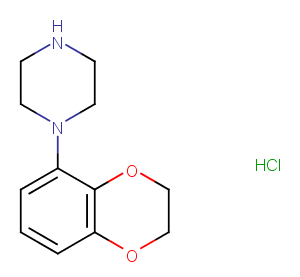Powder: -20°C for 3 years | In solvent: -80°C for 1 year


Eltoprazine hydrochloride (DU 28853 hydrochloride) is a partial agonist at serotonin 5-HT1A, 5-HT1B, and 5-HT2B receptors (Ki value of 40, 52, and 81 nM, respectively).

| Pack Size | Availability | Price/USD | Quantity |
|---|---|---|---|
| 2 mg | In stock | $ 32.00 | |
| 5 mg | In stock | $ 51.00 | |
| 10 mg | In stock | $ 89.00 | |
| 25 mg | In stock | $ 178.00 | |
| 50 mg | In stock | $ 328.00 | |
| 100 mg | In stock | $ 487.00 | |
| 1 mL * 10 mM (in DMSO) | In stock | $ 57.00 |


| Description | Eltoprazine hydrochloride (DU 28853 hydrochloride) is a partial agonist at serotonin 5-HT1A, 5-HT1B, and 5-HT2B receptors (Ki value of 40, 52, and 81 nM, respectively). |
| Targets&IC50 | 5-HT1A:40 nM , 5-HT2B:81 nM, 5-HT1B:52 nM |
| In vivo | Eltoprazine hydrochloride exerts a dose-dependent decrease in aggressive behavior in resident-intruder tests with rats (ID50 = 0.24 mg/kg)[1]. |
| Synonyms | DU 28853 hydrochloride |
| Molecular Weight | 256.73 |
| Formula | C12H17ClN2O2 |
| CAS No. | 98206-09-8 |
Powder: -20°C for 3 years | In solvent: -80°C for 1 year
DMSO: 31 mg/mL (120.75 mM)
H2O: 28 mg/mL (109.06 mM)
You can also refer to dose conversion for different animals. More
bottom
Please see Inhibitor Handling Instructions for more frequently ask questions. Topics include: how to prepare stock solutions, how to store products, and cautions on cell-based assays & animal experiments, etc.
Eltoprazine hydrochloride 98206-09-8 GPCR/G Protein Neuroscience 5-HT Receptor DU-28853 DU 28853 Hydrochloride 5-hydroxytryptamine Receptor Inhibitor DU-28853 Hydrochloride DU 28853 DU28853 inhibit Eltoprazine Hydrochloride DU28853 Hydrochloride Serotonin Receptor DU 28853 hydrochloride Eltoprazine inhibitor
